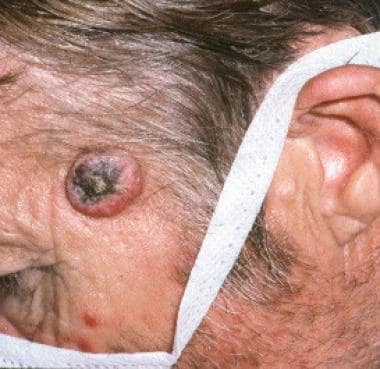Background
Keratoacanthoma (KA) is a relatively common low-grade tumor that originates in the pilosebaceous glands and closely resembles squamous cell carcinoma (SCC). In fact, strong arguments support classifying keratoacanthoma as a variant of invasive SCC. [1, 2, 3] In most pathology/biopsy reports, dermatopathologists refer to the lesion as "squamous cell carcinoma, keratoacanthoma-type." However, some have argued for a distinction between keratoacanthoma and SCC based on gene expression [4] or cutaneous marker. [5]
Keratoacanthoma is characterized by rapid growth over a few weeks to months, followed by spontaneous resolution over 4-6 months in most cases. Keratoacanthoma may progress rarely to invasive or metastatic carcinoma. Whether these cases were SCC or keratoacanthoma, the reports highlight the difficulty of distinctly classifying individual cases. [6, 7, 8, 9]
The image below depicts keratoacanthoma of the left forehead.
See Nonmelanoma Skin Cancers You Need to Know, a Critical Images slideshow, to help correctly identify these lesions.
Pathophysiology
Trauma/local injury, ultraviolet light, chemical carcinogens, human papillomavirus, genetic factors (mutations in p53 or H-Ras), and immunocompromised status have been implicated as etiologic or triggering factors. The introduction of BRAF inhibitor therapy for melanoma and hedgehog pathway inhibitor therapy for advanced basal cell carcinoma have elicited a surge in keratoacanthoma (KA) incidence. [10] Keratoacanthoma is commonly associated with syndromes such as Muir-Torre syndrome, Ferguson-Smith syndrome, xeroderma pigmentosum, and incontinentia pigmenti. There is a rare generalized eruptive keratoacanthoma of Grzybowski.
Keratoacanthoma and conventional SCC share very similar epidemiological features, which suggests a possible common pathogenesis, such as actinic damage. [11] Interestingly, in Palm Springs, California, this author has seen more patients with SCC/keratoacanthoma than straightforward SCC. In population-based studies in Kauai, Hawaii, keratoacanthoma and SCC had a comparable incidence (106 cases per 100,000 population for keratoacanthoma and 118.2 cases per 100,000 population for SCC). [11, 12] Most keratoacanthomas and SCCs developed on head/neck and limbs (keratoacanthoma, 78%; SCC, 85%). The incidence of keratoacanthoma and SCC increased significantly after age 64 years. The average age of patients was 67 years in keratoacanthoma and 66 years in SCC. Male-to-female ratios for both conditions were similar, at 2:1. [11]
Etiology
The definitive cause of keratoacanthoma (KA) remains unclear; however, several potentiating factors should be considered. Epidemiologic data of keratoacanthoma is notably similar to SCC and Bowen disease (SCC in situ) concerning age, sex, and the anatomic site of lesions. These data strongly support a common etiology among keratoacanthoma, SCC, and Bowen disease. Epidemiologic data support ultraviolet light as an important etiologic factor.
Industrial workers exposed to pitch and tar have been well established as having a higher incidence of keratoacanthoma, as well as SCC. [13] Additionally, a 2006 study suggested a strong association between cigarette smoking and the development of keratoacanthoma. [14]
Trauma (iatrogenic or noniatrogenic), human papillomavirus (specifically types 9, 11, 13, 16, 18, 24, 25, 33, 37, and 57), [15, 16] genetic factors, and immunocompromised status also have been implicated as etiologic factors.
Merkel cell polyomavirus does not play a pathogenic role in keratoacanthoma. [17]
Twenty percent of patients who had metastatic melanoma and were treated with vemurafenib, a novel BRAF V600E inhibitor, may develop eruptive keratoacanthoma or squamous cell carcinoma. [18]
Finally, research has identified that up to one third of keratoacanthomas harbor chromosomal aberrations. Recurrent aberrations include gains on 8q, 1p, and 9q with deletions on 3p, 9p, 19p, and 19q. One other report identified a 46,XY,t(2;8)(p13;p23) chromosomal aberration. [19, 20, 21, 22]
Epidemiology
Frequency
United States
The sole published study on keratoacanthoma (KA) in a white US population took place in Hawaii and estimated the incidence at 106 cases per 100,000. This study reported keratoacanthoma incidence equal to SCC and challenged the commonly reported incidence ratio of keratoacanthoma to SCC of 1:3. Peak incidence occurs in the seventh decade or beyond. Keratoacanthoma is uncommon in darker-skinned patients. [11, 23, 24, 25]
International
Based on the Hawaiian data, the incidence of keratoacanthoma in ethnic Japanese, Filipino, and Hawaiian populations has been estimated to be 22, 7, and 6 cases per 100,000 population, respectively, approximately one fifth to one sixteenth of the incidence rate found in American whites. In other studies, the ratio of keratoacanthoma to SCC has ranged from 1:0.6 to 1:5 in different geographic locations. [11, 23, 24, 25]
Race
Keratoacanthoma is less common in darker-skinned individuals.
Sex
The male-to-female ratio for keratoacanthoma is 2:1.
Age
Keratoacanthoma has been reported in all age groups, but incidence increases with age. Keratoacanthoma is rare in persons younger than 20 years.
Prognosis
The prognosis for keratoacanthoma is excellent following excisional surgery. Recurrent tumors may require more aggressive therapy. Follow patients with a history of keratoacanthoma for development of new primary skin cancers (SCC in particular). It has been reclassified as SCC-KA type to reflect the difficulty in histologic differentiation. Uncommonly, keratoacanthomas may exhibit an aggressive growth pattern. Keratoacanthoma infrequently presents as multiple tumors and may enlarge (5-15 cm), become aggressive locally, or rarely, metastasize. [26, 27]
Patient Education
Educate patients about prevention (including sunscreen), sun-protection techniques, and skin self-examination.
-
Keratoacanthoma (squamous cell carcinoma-keratoacanthoma or SCC-KA type) on inner canthus.
-
Keratoacanthoma of the left forehead.
-
Close-up view of the keratoacanthoma.
-
Keratoacanthoma lesion (squamous cell carcinoma-keratoacanthoma or SCC-KA type).








